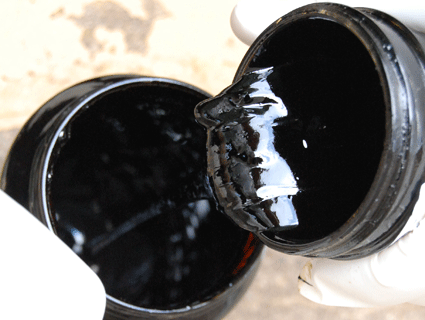
Image courtesy of Gabe Elsner
Crude oil from the March 29 pipeline spill in Mayflower, Arkansas contained enough of the carcinogen benzene to pollute as much as 188 million gallons of drinking water—or enough to fill 284 Olympic-sized swimming pools—according to figures the Environmental Working Group (EWG) released Thursday. The oil also contained toxics like toluene, ethylbenzene, lead, and chromium, according to independent lab testing conducted for EWG.
The spill from Exxon’s Pegasus pipeline dumped 210,000 gallons of bitumen, a particularly nasty type of crude oil from Canada’s tar sands, into an Arkansas neighborhood. The spill provided further fodder to critics of the proposed Keystone XL pipeline, which would carry the same type of oil. The presence of those chemicals in the sample is not a surprise, really; they are found in most forms of crude oil. But EWG’s director of research, Renee Sharp, said the 4.5 parts per million of benzene the tests found were “concerning” because, when extrapolated out to the total gallons spilled, that’s enough benzene to contaminate between 132 and 188 million gallons of drinking water beyond the levels EPA deems acceptable.
What’s perhaps more interesting, however, is how the sample made its way to EWG. Billionaire clean tech investor Tom Steyer asked a local resident of Mayflower to gather the sample. The resident put it in a Tupperware container, and someone drove it to DC and passed it off to a PR firm working with Steyer. The PR firm eventually gave it to EWG, which hired a lab to run the tests.
Steyer, a big donor to President Barack Obama’s campaign, has made the proposed Keystone XL pipeline a major focus of his attention—and his spending. He’s promised to raise holy hell if the Obama administration approves the pipeline, which would carry nearly 900,000 barrels of bitumen through the US every day. You can see a photo of Steyer holding the oil in a mason jar in this Bloomberg profile. On Thursday morning, Steyer, EWG, and other environmental organizations will kick off a “Stop Keystone” social media campaign aimed at swaying the Obama administration.
Because the Mayflower resident didn’t collect the oil using more conventional methods for environmental surveys, EWG says it’s likely that amount of chemicals the analysts found were underestimates. Other chemicals, like volatile organic compounds, may have evaporated between the time it was collected and the time they did the analysis. But the chemicals they did find no joke: toluene exposure causes damage to the nervous and the kidneys, and exposure during pregnancy can cause birth defects; ethylbenzene is another carcinogen and may damage the nervous system. Other chemicals present in the sample can damage the respiratory system and skin.
Sharp also expressed concern about the chemicals that EWG didn’t test for—because no one actually knows what is in the oil traveling through these pipelines. Bitumen in its natural state is viscous or even solid; in order to transport the oil, companies add other chemicals to make it move through the pipes. This mixture is called diluted bitumen, or “dillbit,” but the companies guard the chemical mixture as a trade secret. The lab can’t test for chemicals that they don’t know about. (You can read the Pulitzer Prize-winning series from Inside Climate for more on the issues surrounding this type of oil.)
Those unknowns, too, should be discussed in the context of Keystone, says Sharp. The pipeline would pass over, under, and through aquifers, rivers, and other ground water sources. “We’re debating this massive pipeline project,” she says, “and we still don’t know what is actually going to be transported in the pipeline.”






